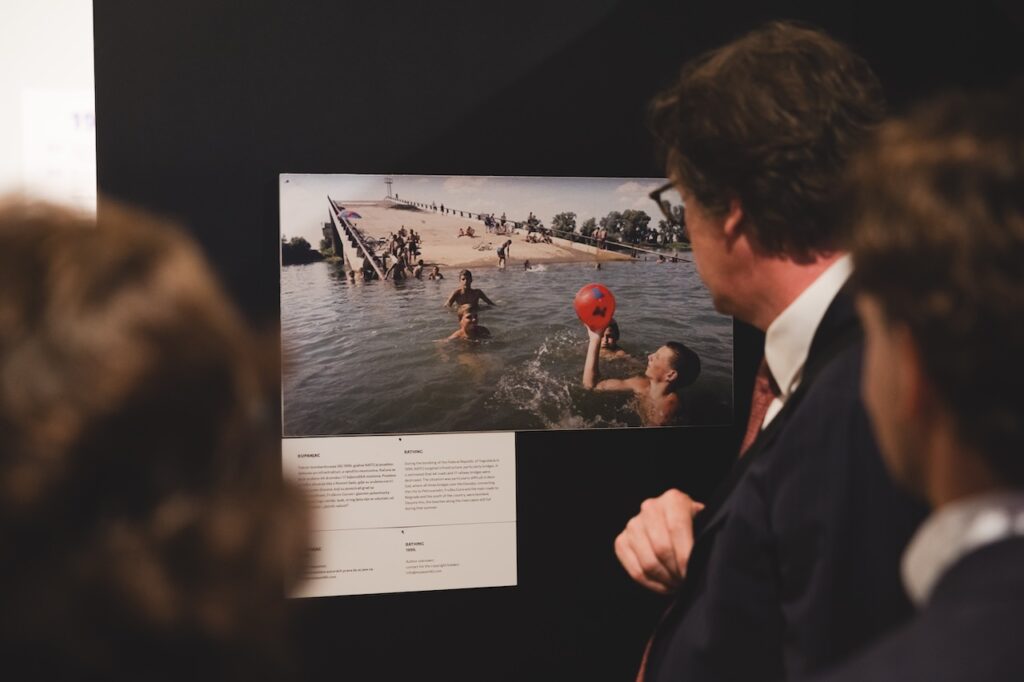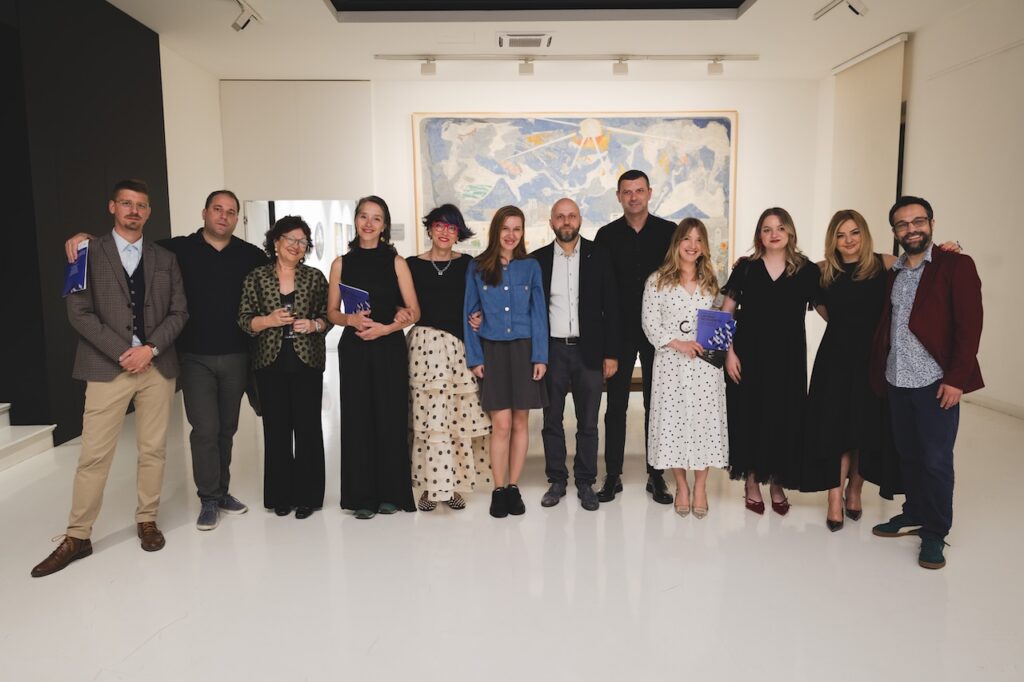This exhibition is not merely a cultural event – it is a call to remembrance, critical reflection, facing the complex legacy of the nineties, accountability, and dialogue. And it is not from the past – it is about the present shaped by that past, and about the future we can still change, as highlighted during last night’s opening of the exhibition “The labyrinth of the nineties” at the Modern Gallery in Podgorica.
“The exhibition ‘The labyrinth of the nineties’ does not tell visitors what to think nor does it offer final answers. It invites us to reflect, to reconsider, and perhaps even to empathize with perspectives we have not understood before. That is why this is not just a museum of the past – it is also a glimpse into the future”, said Mark van der Linden, Deputy Ambassador of the Kingdom of the Netherlands, opening the exhibition. He praised all those behind the Museum of the nineties initiative, emphasizing the importance of critically engaging with the past and drawing on the experience of his own country. “Every country has s past which it must look at honestly. I speak from personal experience. I was born and raised in the Netherlands in the 1970s. In school, we were taught that my country stood on the right side of history during the World War II – that we were part of the resistance. While that narrative contains elements of truth, I later realized it was not complete. The reality was far more complex. Yes, there were acts of courage and solidarity, but also silence, complicity, and collaboration – aspects that were not openly discussed for years. As a nation, we are still confronting those truths and continue to reassess the uncomfortable parts of our history. Without that process, we cannot grow or build genuine trust”, he explained. “Unresolved issues such as nationalism, populism, and violence openly threaten peace, stability, and prosperity. If we want a future based on mutual understanding and trust – instead of suspicion and resentment – we must be willing to question our own role and responsibility, not just that of others”, Van der Linden concluded.
The Ambassador of the Republic of France to Montenegro, Anne-Marie Maskay, emphasized the uniqueness of this exhibition in addressing the decade that transformed millions of lives in the Western Balkans. “What makes this exhibition original is the way it deconstructs traditional frameworks for telling the 1990s, opening space for the possibility of building a new, multilayered and multidimensional vision, created from the remnants of those old frameworks – a vision that encompasses different temporal experiences, different value systems, ideologies, imaginations, suffering…”, she said. She added that through shared steps in the same direction, progress and healing can be strived for – towards building a society that remembers, that strives to be more just, open, and resilient. Maskay noted that the exhibition seeks to achieve exactly that and that it fits excellently within the framework of the Shared Horizons project, launched several months ago with the aim of strengthening dialogue and cooperation among youth in the Western Balkans.
“We are very excited about this exhibition in Podgorica. This is just part of our work in Montenegro, which we carry out in cooperation with the Centre for Civic Education (CCE), and which also includes programs with youth from the region through summer schools on the nineties, as well as work with a new generation of Montenegrin historians, among whom are Miloš Vukanović, Filip Kuzman and Vukan Ražnatović”, said historian DubravkaStojanović, one of the exhibition’s authors. She recalled that this exhibition, after Belgrade and Sarajevo, is coming to Podgorica, announcing an important new stage in its development – the opening of a permanent display on 2 June in Belgrade, through the project “Museum of the nineties.” “We want to put the 1990s in a museum – not to forget them, but so that we constantly think about them and, as societies and individuals, never return to them again”, said Stojanović.
Igor Štiks, writer and co-author of the exhibition, believes that post-Yugoslav societies still have an important task – to seriously engage with the nineties and their legacy, which also includes the work of placing that decade “in some museum.” “It is history that happened, which is not easy, but which we hope will one day no longer determine our lives. In that sense, this exhibition, on the one hand, invites us to confront the things that happened in the nineties, and on the other hand, retains hope that through a creative act, such as visiting an exhibition, it is possible to overcome the burden of the past and open up to a completely different future”, said Štiks.
“It is a great pleasure for me that tonight in Podgorica we have the opportunity to present this important exhibition, which emerged as a result of regional cooperation and the desire to present a turbulent historical period in a different way – one that continues to spark debates, discussion, and research”, said Ivana Ćupić, Director of the Public Institution Museums and Galleries of Podgorica, expressing hope that the exhibition “The labyrinth of the nineties” will contribute to further affirmation of a culture of remembrance, social responsibility, and open dialogue about sensitive topics from our recent past. “The focus is not on institutions, but on individuals. It is our responsibility, as institutions and as a society, to create spaces in which these topics can be discussed freely and openly, based on facts and with awareness of the context”, Ćupić concluded.
“I belong to the generation that remembers the 1990s not only through personal experiences but also through political reality. Those were the years that shattered the world for many, that left indelible traumas. These are wounds that are still carried today – often invisibly, quietly, but deeply – and that are, consciously or not, passed on to new generations. The 1990s led us into a labyrinth of violence, hatred, and manipulation – a labyrinth we, as societies, have yet to fully emerge from. But it was also a decade in which some showed dignity and courage, resistance and solidarity. This exhibition invites us not to run away from that complex puzzle”, said Daliborka Uljarević, Executive Director of the CCE, expressing gratitude to the authors for the inventiveness, knowledge, and emotion they poured into the exhibition. “I hope you leave this labyrinth with more questions than answers – because that is exactly where change begins, and change is what we need …”, she concluded.
The exhibition will be open to the public every day (except Mondays) at the Modern Gallery, from 9:00 to 20:00, until 13 September 2025.
The exhibition “The labyrinth of the nineties” in Podgorica is organized by the M90 Foundation and Cultural Front from Serbia, in cooperation with the Centre for Civic Education (CCE) from Montenegro. The exhibition is part of the project “Museum of the 90s – Regional Center for Reconciliation, Education, and Future Cooperation”, supported by the Ministry of Foreign Affairs of the Kingdom of the Netherlands through the MATRA programme, the European Fund for the Balkans (EFB), and the Shared Horizons project funded by the Republic of France and implemented by Expertise France Groupe AFD. The content of this exhibition is the sole responsibility of the authors and does not necessarily reflect the views of the donors.
Maja Marinović, Programme Associate





